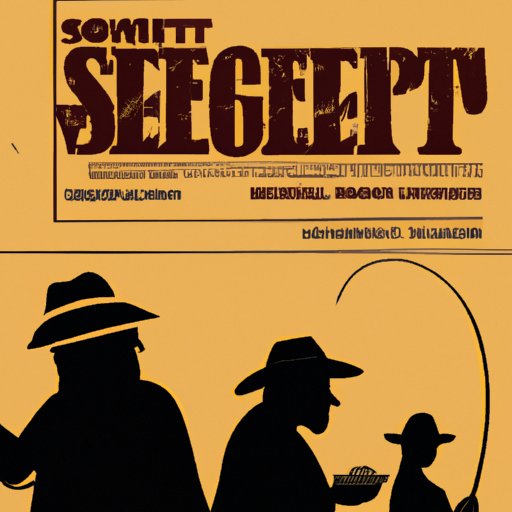Introduction
When one hears the term “spaghetti western”, confusion and curiosity tend to arise. Is it a cuisine? A style of filmmaking? This is where a comprehensive guide comes in handy. The purpose of this article is to provide readers with a thorough understanding of what exactly a spaghetti western is, its history, its main elements, iconic directors and films, must-watch list, and its legacy in modern cinema.
Exploring the History of Spaghetti Westerns: A Comprehensive Guide
A spaghetti western is a western film made by Italian crews, mostly shot in Italy or Spain, and often featuring American actors. The genre got its name from Italy’s contemporary state of cinema and its perception as cheap and low-quality. Sergio Leone’s “A Fistful of Dollars” (1964) was the first big international success, followed by many others. The genre flourished up until the mid-1970s, when it fell into a decline.
Some of the most influential spaghetti western directors include Sergio Leone, Sergio Corbucci, and Enzo G. Castellari. Iconic films include “The Good, The Bad and The Ugly” (1967), “Django” (1966), and “Once Upon a Time in the West” (1968).
Demystifying Spaghetti Westerns: What You Need to Know
One common misconception about spaghetti westerns is that they’re all cheap imitations of Hollywood westerns. In reality, they were made in the context of new cinema movements in Italy and were often much grittier and more low-budget than their American counterparts. Moreover, the cultural and historical context in which these films were made was heavily influenced by post-WWII European society and politics. Key themes and motifs include skepticism of authority, individualism, and revenge.
Behind the Scenes: The Making of a Spaghetti Western
A hallmark of spaghetti westerns is their unique look and feel. Often set in the Spanish deserts and using extras from Italian army barracks, these films made use of a distinct style of cinematography, music, and costume. The soundtracks, composed by greats such as Ennio Morricone, were largely made up of twangy electric guitar riffs and haunting harmonicas.
Analyzing the Elements of a Spaghetti Western Film
Spaghetti westerns are known for their emphasis on violence and anti-heroes as protagonists. The landscapes, music, and settings of these films were also crucial to the overall mood and atmosphere. For example, the arid Spanish desert served as the backdrop for many iconic scenes, such as “The Good, The Bad and The Ugly” finale.
Top 10 Must-Watch Spaghetti Westerns of all Time
1. “The Good, The Bad and The Ugly” (1966) directed by Sergio Leone: the perfect introduction to the genre and one of the most iconic collaborations between Leone and Morricone.
2. “Once Upon a Time in the West” (1968) directed by Sergio Leone: hailed as one of the greatest westerns ever made.
3. “Django” (1966) directed by Sergio Corbucci: a tale of revenge that’s both gritty and iconic.
4. “The Big Gundown” (1966) directed by Sergio Sollima: a complex revenge story with a memorable soundtrack by Ennio Morricone.
5. “A Bullet for the General” (1966) directed by Damiano Damiani: another example of an anti-establishment hero in a complex milieu.
6. “The Great Silence” (1968) directed by Sergio Corbucci: an allegoric tale of resistance with one of Morricone’s most haunting soundtracks.
7. “Day of Anger” (1967) directed by Tonino Valerii: one of the best examples of the apprenticeship theme, in which a young man learns and surpasses his master.
8. “The Mercenary” (1968) directed by Sergio Corbucci: Franco Nero and Jack Palance in one of their most charismatic roles against the backdrop of the Mexican revolution.
9. “Companeros” (1970) directed by Sergio Corbucci: Franco Nero and Tomás Milián team up amidst revolution and corruption in Mexico.
10. “Sabata” (1969) directed by Gianfranco Parolini: a James Bond-esque hero with a unique arsenal of gadgets and weapons taking on the corruption and the mercenaries of the Wild West.
The Legacy of Spaghetti Westerns: How They’ve Influenced Modern Cinema
The influence of spaghetti westerns has stretched far beyond the genre itself. Many contemporary filmmakers, including Quentin Tarantino, have cited spaghetti westerns as major inspirations for their work. Key themes and styles that originated in this genre are still seen in action movies, thrillers, and even horror films. Despite some criticisms of the genre’s treatment of violence and women, the spaghetti western has nonetheless cemented its place in the pantheon of classic cinema.
Conclusion
Spaghetti westerns may have been perceived as cheap and low-quality at one point, but the genre has stood the test of time. Their influence can be seen in many of today’s films. From their unique settings and style to their iconic soundtracks, these films have left an indelible mark on the history of cinema. Whether you’re a fan of the genre or an interested beginner, the spaghetti western is definitely worth exploring further.
